Welding utilizes electric power to create an arc between an electrode and base metal. In this process, the power supply, or the welder, utilizes the power electrical network (input power), forms an arc, and welds two pieces at a selected amperage (output power).
Whether you’re a seasoned welder or just beginning to explore the art of joining metals, understanding the intricate relationship between input and output power in welding is essential.
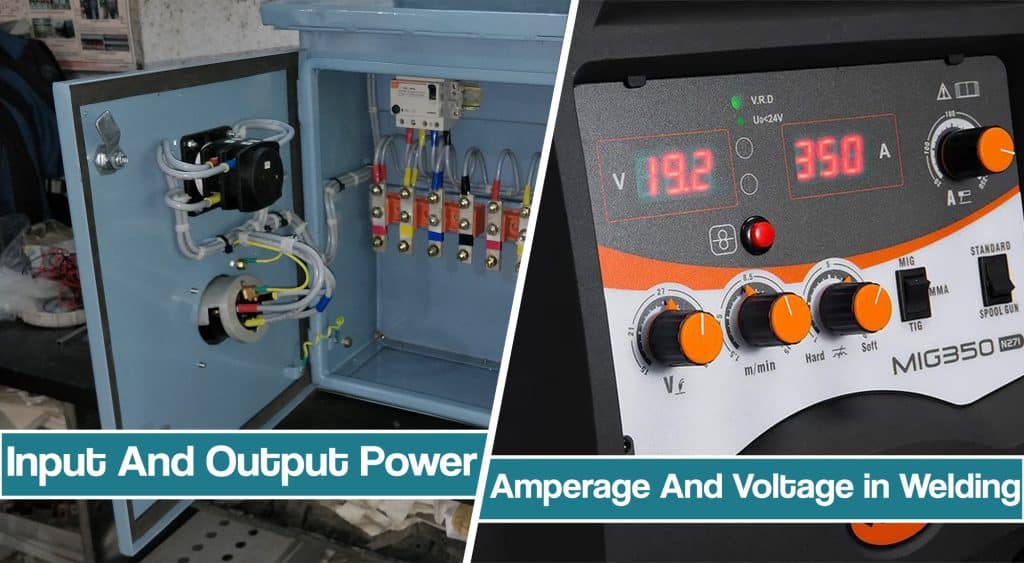
In this article, we’ll thoroughly explain the basic electricity in welding, including the voltage and amperage and the changes they to to the arc and overall welding performance.
What is Input Power In Welding?
Input power, primary power, or primary voltage is the electrical energy supplied to your welding machine (power supply), from an electrical grid or power generator. This is a constant voltage, commonly rated at 110 V (110/115), 208V (200), 230V (220/240), 460V (440-480), or 600 VAC, or Volts of Alternating Current.
The input power utilizes AC current at 50-60 Hz and one to three phases depending on the rated output power.
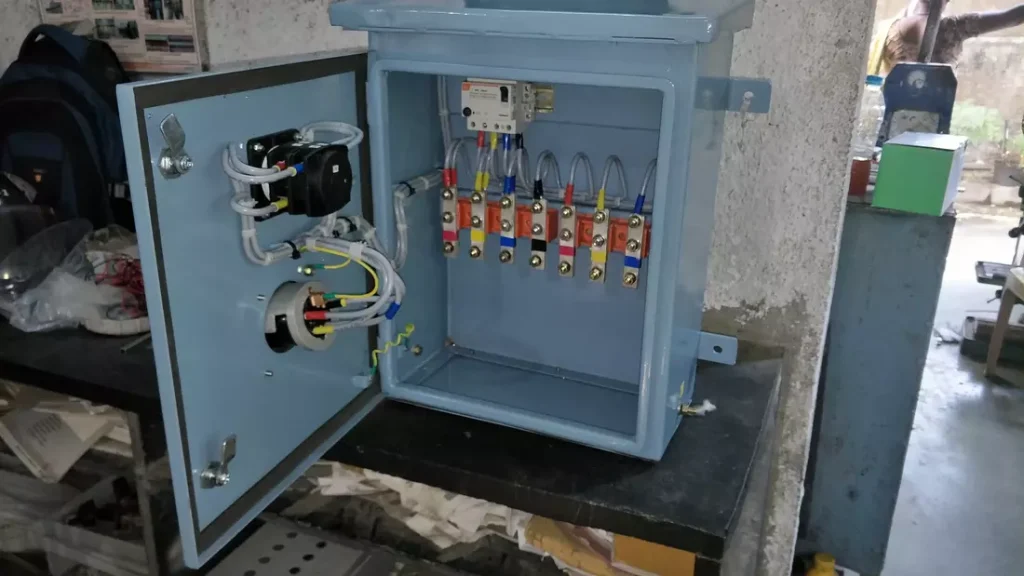
Simply put, this is the power your welder needs to produce an arc and enough heat to melt two pieces and weld them together. For example, most 110 V welders are rated at 140 amps, home-use 220V welders go up to 250 amps, while industrial-grade machines utilize three-phase 460 V or higher input at more than 300 or even 600 output amperage.
The Role Of Power Supply (Welder) In Welding
Additionally, the Gas Metal Arc Welding process (MIG), Flux Cored Arc Welding, and the biggest part of Stick welding utilize a Direct current, but the electrical grid provides an Alternating current.
The welder, therefore, transforms the primary type of current to fit it into the desired process. Based on the way they transform input power into output power, a welding power supply can be either a transformer, transformer/rectifier, or an inverter.
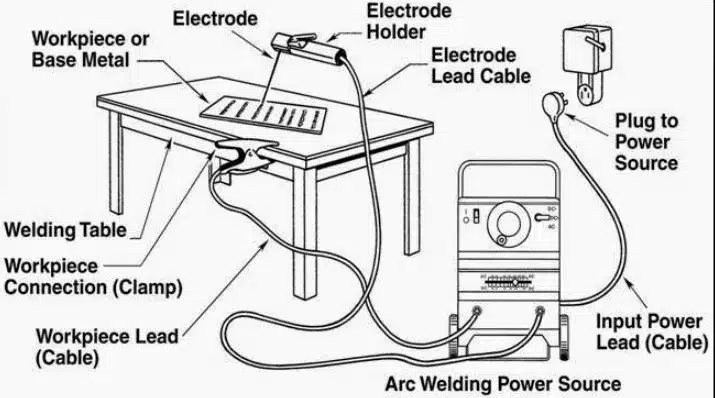
- Transformer welders are older, robust, and heavy welding machines that have proven reliable and durable. These were one of the main types of power supplies, but they came with a list of setbacks. The internal components make these welding machines extremely heavy, and they are considered less energy efficient, as only a portion of input was converted into output, while the consumption remains high. You can recognize the transformer welder by tapped controls with predetermined amperage values, which makes fine-tuning really hard.
- Inverter welders made a revolution in the market as they combine excellent welding arc performance, with energy and weight saving. Transistors inside them convert mains AC (50Hz) to high-frequency AC (>500Hz) before transforming down to a suitable voltage for welding and then rectifying to DC. As a result, you can fine-tune your arc to a single amp or volt, and they open the opportunity for pulsed MIG and dynamic feedback to control metal transfer. There are very few drawbacks, usually when
What Is Output Power In Welding?
The welding power source machine utilizes primary power and transforms it into a welding output that is then used to form an arc, melt the pieces, and weld them together. The welding output is somewhat more complicated than the input, as it welding arc is dynamic, and it depends on an arc current (A) and arc voltage (V). As a beginner, the difference between these two settings on your arc welding machine might seem pretty confusing, but there are differences in how these two affect arc.
Amperage in Welding
The welding current is the variable that mainly controls the amount of weld metal deposited during the welding process.
Amperage measures the strength of the electrical current, with its primary effect on welding being the melt-off rate of the electrode and the depth of penetration into the base material.
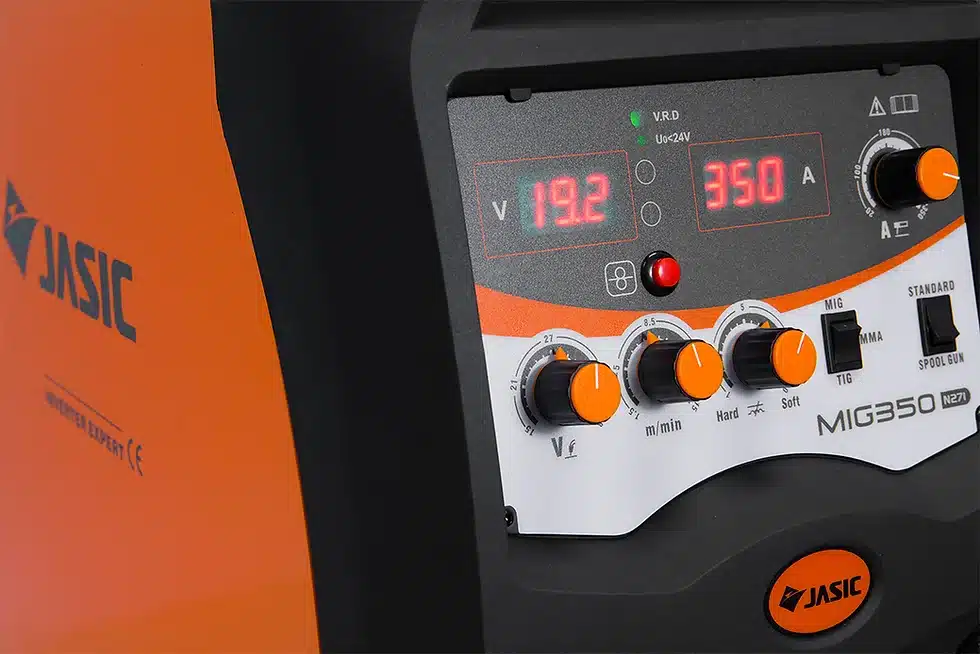
The higher the current, the higher the deposit of the weld metal, and the higher the weld penetration. It is that simple. The higher the current level, the faster the electrode melts or the higher the melt-off rate, measured in pounds per hour (lbs/hr) or kilograms per hour (kg/hr). The lower the current, the lower the electrode’s melt-off rate becomes.
Voltage In Welding
Voltage in welding measures the difference between the positive and negative sides of the cycle, creating the pressure that allows electrons to flow.
Voltage controls the length of the welding arc (the distance between the electrode and base metal) and the resulting width and volume of the arc cone. As voltage increases, the arc length gets longer (and arc cone broader), while as it decreases, the arc length gets shorter (and arc cone narrower).
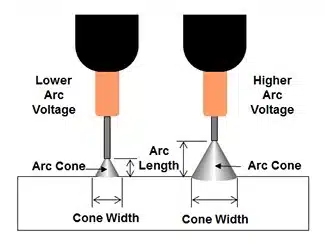
Open Circuit voltage And Closed Circuit Voltage
Once you start your welding machine, it receives the input from the grid, and the voltage is pumped through your equipment. However, you don’t start welding until you touch the base metal with your electrode or welding wire. If the circuit is not complete, you are not welding; the circuit is said to be an open circuit, and you have an open circuit voltage (OCV).
Once you touch the base metal and complete the circuit, you will start welding, and the current-voltage is known as closed circuit voltage. OCV is always higher than that of the closed circuit. Voltage is potential energy. So, it needs a higher voltage to initiate the arc. However, keep in mind that high OCV can be potentially dangerous to welders. If you close the circuit while changing the electrode or preparing the wire, you can get shocked. That’s why many modern welders use Voltage Reduction Device (VRD), which reduces the OCV, but pumps it up back before you start a weld.
Constant voltage and Constant Current (CC and CV) Output
Since the arc is highly dependent on voltage and amperage changes, welding machines usually make one of the variables constant. Whether does the machine provides constant output voltage, or current depends on the specific welding process. When you use the wrong type of output with each respective process, the arc conditions can be very unstable.
Constant Current Output
Gas tungsten arc welding (TIG Welding) and Shielded Metal Arc Welding are known as manual welding processes. Within these, you have to manually control all variables by hand (which is why they are the two most operator-skill-intensive processes).
To achieve consistent results and sound weld, you must have a consistent electrode melt-off rate. However, your machine needs to maintain current at a constant level, therefore, it needs a CC (constant current) output.
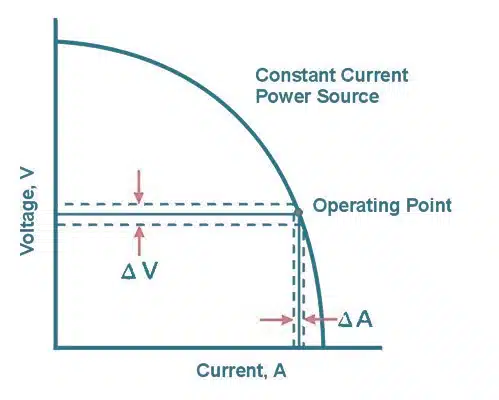
Therefore, when using a TIG welder or Stick welding machine, you set the amperage by using a knob, and the machine keeps it consistent until you finish your welding or change it. Meanwhile, you control the arc length by manipulating your electrode holder or tig torch according to your needs.
If you try TIG or Stick welding with a CV power supply, you’ll encounter multiple issues that are related to inconsistent melt-off. For example, if you try running a Stick weld, the current fluctuations will cause the electrode to melt at different rates during a single weld, resulting in lack of penetration or incomplete fusion, or excessive penetration and weld metal deposition inside a single joint.
Constant Voltage Output
MIG welding and Flux Core Arc Welding are known as semi-automated processes, that use constant-speed wire feeder. This feeder constantly feeds the electrode at a selected wire feed speed, so you don’t have to worry about the current fluctuations. The voltage-sensing wire feeder adjusts current proportionally to wire feed speed, while you only control voltage, and shielding gas flow.
When using a Flux core or MIG welder, you’ll have to adjust WFS and voltage, usually by using two knobs, while the current is measured during the welding. So, if you want to change the arc length you have to change the arc voltage via the machine.
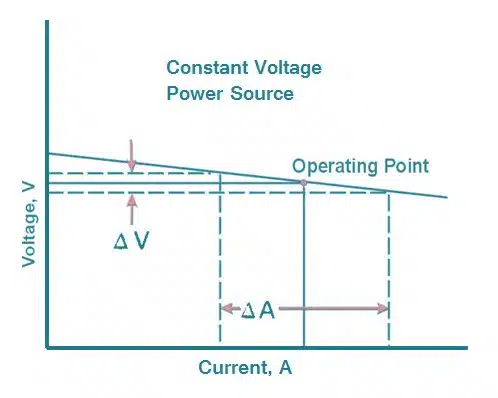
If you try MIG welding with a CC power supply, the arc length will vary. During a single weld, an arc becomes very short, and the electrode stubs into the plate. Then, as the voltage increased, the arc length would become very long, and the electrode would burn back toward the contact tip. These two conditions would change during the course of a single weld.
Keep in mind that there are some processes, such as Submerged arc welding, that can benefit from both CC or CV, depending on the results you need to achieve. It is similar with pulse welding, in which the machine changes the voltage and current welding variables and electrical characteristics at extremely fast rates in order to achieve pulsing characteristics.
Conclusion On Input And Output Power In Welding
Understanding the electrical energy behind your welder and welding processes is crucial in achieving strong weld and consistent results. By understanding how current and voltage affect the arc, you can deal with most of the issues you are having with your welds. Additionally, knowing what kind of output voltage your welder produces can also be beneficial in achieving solid and sound welds.
Resources
- https://www.twi-global.com/technical-knowledge/faqs/faq-what-are-the-basic-power-source-designs-for-arc-welding-equipment
- https://www.lincolnelectric.com/en/welding-and-cutting-resource-center/process-and-theory/constant-current-vs-constant-voltage-output
- https://primeweld.com/blogs/news/understanding-voltage-amperage-in-welding
- https://technoweld.com.au/2019/05/30/the-basics-of-electricity-in-welding/
- https://www.millerwelds.com/-/media/inriver/sampletopic3247360.pdf





